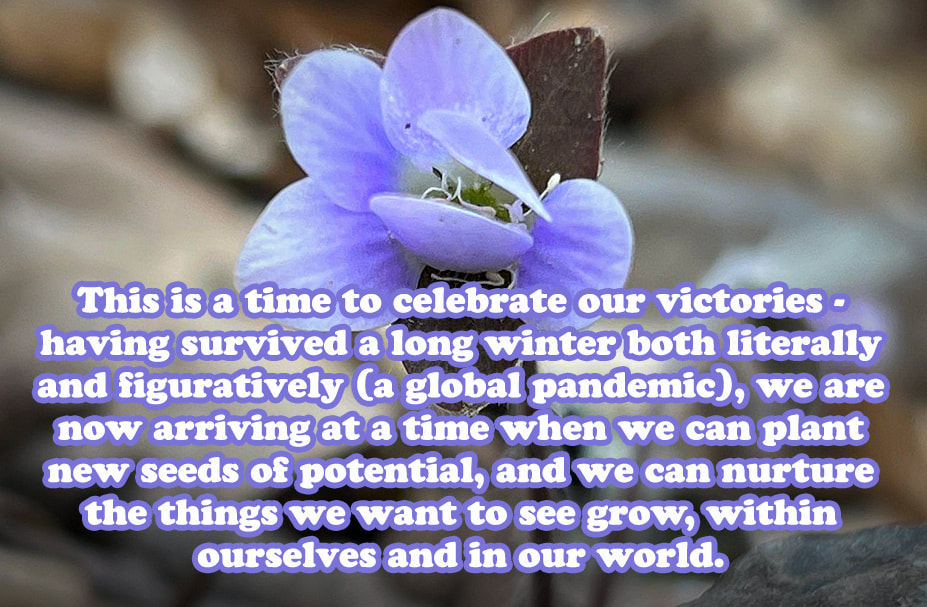|
Celebrating life while honoring death It’s the first day of spring and with the new season officially here now, there is so much we can celebrate and look forward to. This is a time to celebrate our victories—having survived a long winter both literally and figuratively (a global pandemic), we are now arriving at a time when we can plant new seeds of potential, and we can nurture the things we want to see grow, within ourselves and in our world. Photo by Tracy Coon Soon our environment will be blooming with new life. Yet right now much of that life is still unseen potential. The trees around us are still mostly naked without their leaves, we can still see the leaves they’ve shed over the past few seasons littering the ground and we still have many cold days ahead of us. There is so much we can learn from the seasons and the way they shift, so much we can apply to our lives, with the awareness that our bodies are a part of nature, our lives reflect the cycles and other principles of nature as well. Spring has arrived, yet this does not mean winter is suddenly and magically gone forever. We still have to mourn and to grieve all that we’ve lost over this long winter. This is part of the process for transforming and integrating those losses so that they can become fuel for new ideas, experiences and relationships to bloom in our lives. In nature, death is the fuel that feeds new life. Here where I live, in the forests we can see the leaves that were shed by the trees throughout the fall and winter become the compost that nourishes the soil to grow and sustain life in the spring. Trees that fall and die become a part of the new landscape, shaping new highs and lows on the ground as new layers of soil eventually cover them. Animals that die become food for other animals to survive and carry on with their unique and important roles in their ecosystems, and become nourishment for the soil underneath. Death and life are inextricably linked. Without death, there could be no life. Likewise in our lives, we experience many deaths… both literal and figurative. Yet all those deaths can be transformed into new life. When we allow ourselves to mourn them and to honor them, we can witness this transformation as it occurs. We’ve all lost so much over this long winter. We’ve all lost old ways of living life or old ways of being we’d grown accustomed to. Many of us have had to give up dreams, or parts of a future we’d envisioned for ourselves, when we thought the future would be different from what it ended up becoming. Many of us lost jobs, or old ways of doing our work, or the ways we used to think about our work, the value of our work, and our purpose in the world. All of us lost people who were near and dear to our hearts. Some of us walked away from harmful relationships, or had to come to terms with someone we loved choosing to walk a different path. Most of us were touched by the deaths of loved ones, whether it was a tragic death from the virus, or a sudden and unexpected accident, or an expected death from long illness or old age… losing a loved one is never easy. And it’s always so painful knowing that a loved one is gone forever, in their physical form. We need to give ourselves the space to grieve and to mourn. When we give ourselves that space, and we honor our losses, we can transform even the deepest losses into nourishment… they can become our inspiration for new ways of thinking, new ways of being, new ways of expressing, new ways of interrelating, new ways of acting and creating… There is so much to celebrate right now, so much potential to be excited for as spring begins. Just remember that if you are struggling with loss, if you are feeling pain, if you are mourning… you are exactly where you need to be. Our celebrations of life cannot be separated from honoring and integrating the deaths we experience in our lives. Whatever you are feeling today, feel it fully, let it be your teacher, let it be your guide, let it shape the landscape of the garden you are growing this coming year, let it inform you of which seeds you want to plant, and which plants you want to nourish and help grow. Did You Like This Post?Did you like this post? Would you like to see more like it? If so, comment below letting us know!
You can also visit our blog map to find more of our articles, or subscribe to our newsletter or Facebook page to be the first to find out about our next post. And you'd like to join a supportive community of belly dance students from all over the US and the world, check out our available classes here.
0 Comments
Leave a Reply. |
AuthorYamê is a Brazilian-American View Posts By CategoryIf you'd like to read more articles by Yamê or SharqiDance's guest authors, please view our blog map here.
Archives
January 2024
|



 RSS Feed
RSS Feed